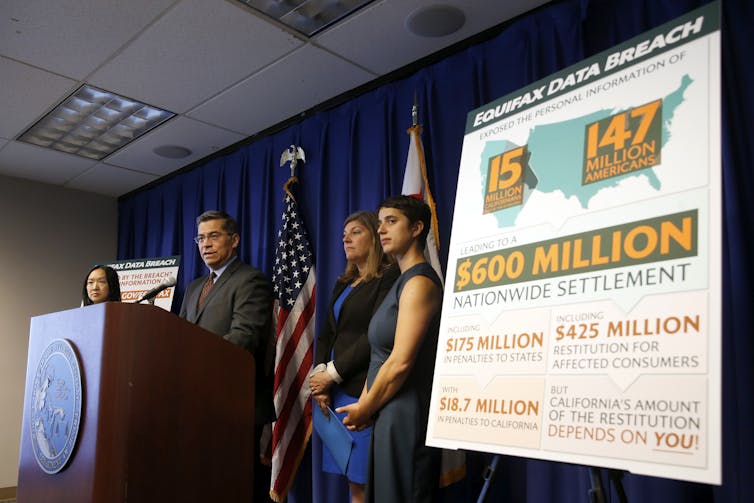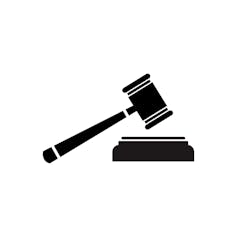Cash or credit monitoring? Choice leads to more just — and cheaper — legal settlements
- Written by Nathan Atkinson, Postdoctoral Researcher in Law and Economics, Swiss Federal Institute of Technology Zurich
If you are among the approximately 147 million people affected by the Equifax data breach, you may be looking forward to your cut of the US$700 million legal settlement[1].
Under the settlement agreement with the Federal Trade Commission, Equifax hacking victims get a choice: free credit monitoring for 10 years or $125 in cash.
Most experts recommended taking the credit monitoring[2], which is valued at thousands of dollars.
Choices in compensation are relatively rare in the law. But my research on legal remedies[3] suggests they shouldn’t be.
Giving plaintiffs choices allows judges to offer different types of compensation to different types of plaintiffs. Doing so actually increases the accuracy of compensation, helping justice be served.
 California Attorney General Xavier Becerra explaining the terms of Equifax’s settlement with the Federal Trade Commission, July 22, 2019.
AP Photo/Rich Pedroncelli[4]
California Attorney General Xavier Becerra explaining the terms of Equifax’s settlement with the Federal Trade Commission, July 22, 2019.
AP Photo/Rich Pedroncelli[4]
Peevyhouse v. Garland Coal & Mining Co.
One of the most famous contract breach cases of all time, Peevyhouse v. Garland Coal & Mining Co.[5], demonstrates the potential benefits of choice in legal compensation.
In 1954, an Oklahoma couple named Lucille and Willie Peevyhouse leased their land to a coal company. The agreement was for the company to strip mine the land in exchange for payment. At the Peevyhouses’ request, the contract also required that company perform restorative work.
The company mined the land and, in 1957, paid the Peevyhouses royalties of $2,500 – which would be $24,000 today.
But the land was never restored.
Lucille and Willie Peevyhouse were left with a farm marred by an open mining pit and massive piles of upturned earth. They sued the company. At trial, the company admitted that it had not performed the restorative work.
The Peevyhouses asked for $25,000 in compensation, which reflected their perceived loss.
The coal company had a different view. Restoring the Peevyhouses’ land would cost $29,000, according to an expert witness, but only increase its value by $300. The company said it was happy to make the Peevyhouses whole by paying the $300.
The judge’s dilemma
Every fall, thousands of first year law students read the Peevyhouse case. Asked to consider what it means to “compensate” someone for harm done to them, the students learn that there are two types of harms: objective and subjective.
In the Peevyhouses’ case, the objective harm of $300 was straightforward. If they were to sell their land, it would now sell for $300 less than if it had been restored.
But the Peevyhouses didn’t care about what others were willing to pay. It was their land[6]. The farm had previously belonged to Lucille’s parents, and Lucille and Willie now were raising their own family there.
 Agus Mul/Shutterstock.com[7]
They had suffered the objective harm of $300 as well as another, more personal harm – one of unknowable value. A restored farm was worth way more to the Peevyhouses than $300. Subjectively, they felt $25,000 in pain.
Was $25,000 really how much subjective harm the Peevyhouses had suffered? Or were they trying to make a profit?
The problem here – as in many damage lawsuits[8] – is that judges cannot confirm someone’s subjective valuation. It differs from person to person. And, of course, people lie.
If the judge in such cases awards too little, the plaintiffs are undercompensated. If the judge awards too much, the plaintiffs make a profit and defendants pay too much.
Since plaintiffs generally cannot prove the cost of their subjective harm, judges often resort to compensating them for only their objective loss.
In the end, Lucille and Willie Peevyhouse received $300. Four decades later, they still lived on the land. Half of it remained unusable and unsafe.
Benefits of choice
It didn’t have to turn out this way.
My research[9] on how to appropriately compensate plaintiffs for subjective harms indicates that judges should offer plaintiffs in breach of contract suits a choice: accept an intermediate award of damages that sits somewhere between the objective and subjective harms, or order the defendant to perform on the contract.
Suppose that the judge in the Peevyhouse case had offered Lucille and Willie the choice between $5,000 or a court order forcing the company to restore their land.
If the Peevyhouses valued the restored land at more than $5,000, they could have chosen the court order. But if they valued the restored land at less than $5,000, they could have taken the money.
In either case, the Peevyhouses would be more accurately compensated for their subjective value.
By giving plaintiffs choices, judges can separate them into two groups and compensate them differentially. Those with high subjective values opt for the court order and are compensated in a costly manner. And those with low subjective values choose cash and are compensated relatively inexpensively.
The choice fully compensates all plaintiffs. And, on average, the costs are lower for the company being sued than they would be if the subjective compensation was awarded without choice.
More complicated still
Equifax would appear to be a good example of the compensation choice that my research endorses.
The choice between $125 or free credit monitoring should allow those of us affected by the breach to be compensated based on our differing subjective values.
An overwhelming number of people[10], it turns out, prefer the $125 – perhaps because they already have “free” credit monitoring from previous data breaches[11]. Or maybe angry victims just want this rich company to pay – financially – for the harms it caused.
But only $31 million was set aside to pay plaintiffs[12]. That works out to only 21 cents per person if everyone opts for the cash.
Choice in compensation only works if the settlement is big enough to give plaintiffs what they’re promised.
[ Like what you’ve read? Want more? Sign up for The Conversation’s daily newsletter[13]. ]
Agus Mul/Shutterstock.com[7]
They had suffered the objective harm of $300 as well as another, more personal harm – one of unknowable value. A restored farm was worth way more to the Peevyhouses than $300. Subjectively, they felt $25,000 in pain.
Was $25,000 really how much subjective harm the Peevyhouses had suffered? Or were they trying to make a profit?
The problem here – as in many damage lawsuits[8] – is that judges cannot confirm someone’s subjective valuation. It differs from person to person. And, of course, people lie.
If the judge in such cases awards too little, the plaintiffs are undercompensated. If the judge awards too much, the plaintiffs make a profit and defendants pay too much.
Since plaintiffs generally cannot prove the cost of their subjective harm, judges often resort to compensating them for only their objective loss.
In the end, Lucille and Willie Peevyhouse received $300. Four decades later, they still lived on the land. Half of it remained unusable and unsafe.
Benefits of choice
It didn’t have to turn out this way.
My research[9] on how to appropriately compensate plaintiffs for subjective harms indicates that judges should offer plaintiffs in breach of contract suits a choice: accept an intermediate award of damages that sits somewhere between the objective and subjective harms, or order the defendant to perform on the contract.
Suppose that the judge in the Peevyhouse case had offered Lucille and Willie the choice between $5,000 or a court order forcing the company to restore their land.
If the Peevyhouses valued the restored land at more than $5,000, they could have chosen the court order. But if they valued the restored land at less than $5,000, they could have taken the money.
In either case, the Peevyhouses would be more accurately compensated for their subjective value.
By giving plaintiffs choices, judges can separate them into two groups and compensate them differentially. Those with high subjective values opt for the court order and are compensated in a costly manner. And those with low subjective values choose cash and are compensated relatively inexpensively.
The choice fully compensates all plaintiffs. And, on average, the costs are lower for the company being sued than they would be if the subjective compensation was awarded without choice.
More complicated still
Equifax would appear to be a good example of the compensation choice that my research endorses.
The choice between $125 or free credit monitoring should allow those of us affected by the breach to be compensated based on our differing subjective values.
An overwhelming number of people[10], it turns out, prefer the $125 – perhaps because they already have “free” credit monitoring from previous data breaches[11]. Or maybe angry victims just want this rich company to pay – financially – for the harms it caused.
But only $31 million was set aside to pay plaintiffs[12]. That works out to only 21 cents per person if everyone opts for the cash.
Choice in compensation only works if the settlement is big enough to give plaintiffs what they’re promised.
[ Like what you’ve read? Want more? Sign up for The Conversation’s daily newsletter[13]. ]
References
- ^ US$700 million legal settlement (www.nytimes.com)
- ^ the credit monitoring (www.consumer.ftc.gov)
- ^ my research on legal remedies (academic.oup.com)
- ^ AP Photo/Rich Pedroncelli (www.apimages.com)
- ^ Peevyhouse v. Garland Coal & Mining Co. (www.courtlistener.com)
- ^ It was their land (heinonline.org)
- ^ Agus Mul/Shutterstock.com (www.shutterstock.com)
- ^ as in many damage lawsuits (academic.oup.com)
- ^ My research (academic.oup.com)
- ^ overwhelming number of people (www.ftc.gov)
- ^ previous data breaches (yahoodatabreachsettlement.com)
- ^ only $31 million was set aside to pay plaintiffs (www.ftc.gov)
- ^ Sign up for The Conversation’s daily newsletter (theconversation.com)
Authors: Nathan Atkinson, Postdoctoral Researcher in Law and Economics, Swiss Federal Institute of Technology Zurich


